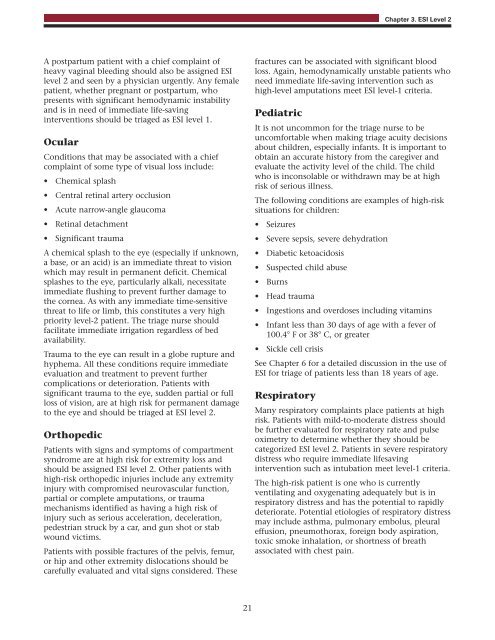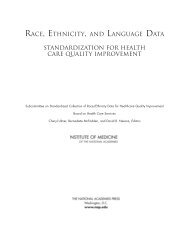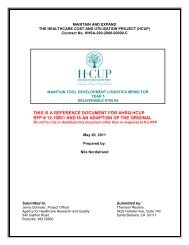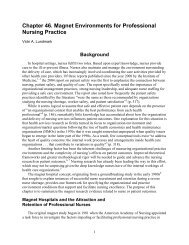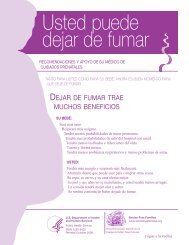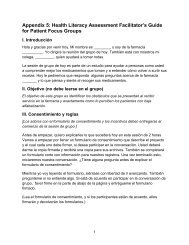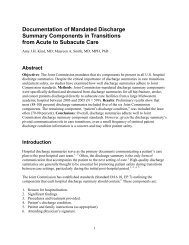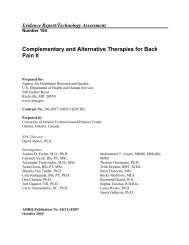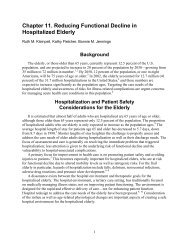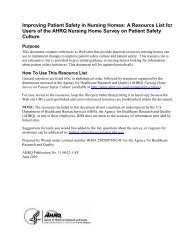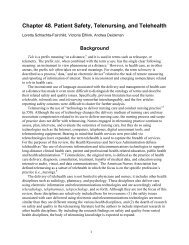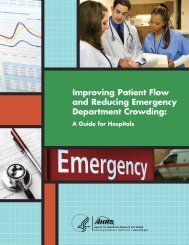Emergency Severity Index (ESI): A Triage Tool for Emergency ...
Emergency Severity Index (ESI): A Triage Tool for Emergency ...
Emergency Severity Index (ESI): A Triage Tool for Emergency ...
Create successful ePaper yourself
Turn your PDF publications into a flip-book with our unique Google optimized e-Paper software.
A postpartum patient with a chief complaint of<br />
heavy vaginal bleeding should also be assigned <strong>ESI</strong><br />
level 2 and seen by a physician urgently. Any female<br />
patient, whether pregnant or postpartum, who<br />
presents with significant hemodynamic instability<br />
and is in need of immediate life-saving<br />
interventions should be triaged as <strong>ESI</strong> level 1.<br />
Ocular<br />
Conditions that may be associated with a chief<br />
complaint of some type of visual loss include:<br />
• Chemical splash<br />
• Central retinal artery occlusion<br />
• Acute narrow-angle glaucoma<br />
• Retinal detachment<br />
• Significant trauma<br />
A chemical splash to the eye (especially if unknown,<br />
a base, or an acid) is an immediate threat to vision<br />
which may result in permanent deficit. Chemical<br />
splashes to the eye, particularly alkali, necessitate<br />
immediate flushing to prevent further damage to<br />
the cornea. As with any immediate time-sensitive<br />
threat to life or limb, this constitutes a very high<br />
priority level-2 patient. The triage nurse should<br />
facilitate immediate irrigation regardless of bed<br />
availability.<br />
Trauma to the eye can result in a globe rupture and<br />
hyphema. All these conditions require immediate<br />
evaluation and treatment to prevent further<br />
complications or deterioration. Patients with<br />
significant trauma to the eye, sudden partial or full<br />
loss of vision, are at high risk <strong>for</strong> permanent damage<br />
to the eye and should be triaged at <strong>ESI</strong> level 2.<br />
Orthopedic<br />
Patients with signs and symptoms of compartment<br />
syndrome are at high risk <strong>for</strong> extremity loss and<br />
should be assigned <strong>ESI</strong> level 2. Other patients with<br />
high-risk orthopedic injuries include any extremity<br />
injury with compromised neurovascular function,<br />
partial or complete amputations, or trauma<br />
mechanisms identified as having a high risk of<br />
injury such as serious acceleration, deceleration,<br />
pedestrian struck by a car, and gun shot or stab<br />
wound victims.<br />
Patients with possible fractures of the pelvis, femur,<br />
or hip and other extremity dislocations should be<br />
carefully evaluated and vital signs considered. These<br />
21<br />
fractures can be associated with significant blood<br />
loss. Again, hemodynamically unstable patients who<br />
need immediate life-saving intervention such as<br />
high-level amputations meet <strong>ESI</strong> level-1 criteria.<br />
Pediatric<br />
It is not uncommon <strong>for</strong> the triage nurse to be<br />
uncom<strong>for</strong>table when making triage acuity decisions<br />
about children, especially infants. It is important to<br />
obtain an accurate history from the caregiver and<br />
evaluate the activity level of the child. The child<br />
who is inconsolable or withdrawn may be at high<br />
risk of serious illness.<br />
The following conditions are examples of high-risk<br />
situations <strong>for</strong> children:<br />
• Seizures<br />
• Severe sepsis, severe dehydration<br />
• Diabetic ketoacidosis<br />
• Suspected child abuse<br />
• Burns<br />
• Head trauma<br />
• Ingestions and overdoses including vitamins<br />
• Infant less than 30 days of age with a fever of<br />
100.4° F or 38° C, or greater<br />
• Sickle cell crisis<br />
See Chapter 6 <strong>for</strong> a detailed discussion in the use of<br />
<strong>ESI</strong> <strong>for</strong> triage of patients less than 18 years of age.<br />
Respiratory<br />
Chapter 3. <strong>ESI</strong> Level 2<br />
Many respiratory complaints place patients at high<br />
risk. Patients with mild-to-moderate distress should<br />
be further evaluated <strong>for</strong> respiratory rate and pulse<br />
oximetry to determine whether they should be<br />
categorized <strong>ESI</strong> level 2. Patients in severe respiratory<br />
distress who require immediate lifesaving<br />
intervention such as intubation meet level-1 criteria.<br />
The high-risk patient is one who is currently<br />
ventilating and oxygenating adequately but is in<br />
respiratory distress and has the potential to rapidly<br />
deteriorate. Potential etiologies of respiratory distress<br />
may include asthma, pulmonary embolus, pleural<br />
effusion, pneumothorax, <strong>for</strong>eign body aspiration,<br />
toxic smoke inhalation, or shortness of breath<br />
associated with chest pain.


